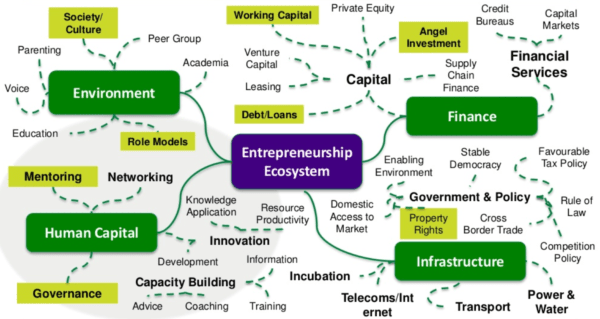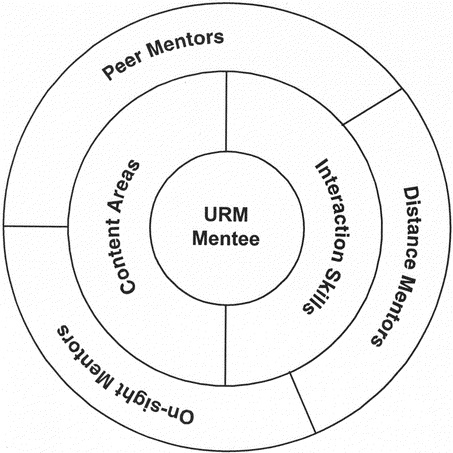Mentorship
You will learn why most Fortune 500 companies are incorporating mentoring as a valuable tool in their talent development, we present critical analyses of the concept, and we detail examples of existing mentorship programs. We also parse the latest data and information on mentoring to provide an overview for those who want to use mentoring to maximize their development and advancement efforts.
In this training, you will
- Learn the data behind mentorship.
- Learn mentoring models.
- Explore the different types of mentors.
- Learn about the mentoring relationship.
- Learn how to build a mentorship program.
- Learn how to match mentors and mentees.
Skills that will be explored
About This Guide:
In this analysis on entrepreneurial mentorship, we explain why most Fortune 500 companies are incorporating mentoring as a valuable tool in their talent development, we present critical analyses of the concept, and we detail examples of existing mentorship programs. We also parse the latest data and information on mentoring to provide an overview for those who want to use mentoring to maximize their development and advancement efforts.
Finding empirical evidence on the value of mentorship programs is difficult. In part, this is due to a lack of theoretical frameworks for entrepreneurial mentoring – a lack of an understanding from which we can develop a strategy, measure results, and identify meaning from mentorship activities.
Compounding the relative lack of qualitative data on the value of mentoring is an ongoing debate among psychologists as to whether entrepreneurism is an innate talent or can be learned. Some think that people either have an entrepreneurial bent or they don’t and that resources spent on mentoring to foster creativity and corporate innovation are better spent elsewhere.
The truth is that theoretical perspectives on mentoring relationships are constantly changing due to workforce demographics, increased diversity, and shifting work-life demands, which alter employees’ needs, expectations, and work relationships. Our research, available data, and case studies show, however, that even in the absence of established frameworks or the consensus of psychologists, mentorship in many forms benefits both mentors and mentees. We also argue that while not everyone possesses the drive or the inclination to become an entrepreneur, the skills required to do so can be learned.
A mentor can be a strong presence during times of both stability and transition, and industry leaders are using mentoring to gain competitive advantage. A Stanford University executive coaching survey found that 80 percent of CEOs received some form of mentorship and in a Sage study, 93 percent of startups stated that mentorship is integral to success. According to a study from the American Society for Training and Development, 70 percent of Fortune 500 companies provide mentorship opportunities.
And it’s not just tech companies who have stopped debating the merits of and started investing in mentorship programs. Consider the following match-ups: Eric Schmidt mentored Google’s Larry Page and Sergey Brin; Facebook’s Mark Zuckerberg was mentored by Steve Jobs; and Steve Jobs was mentored by Mike Markkula, an early investor and executive at Apple.
The Data Behind Mentorship
Stanford Engineering’s Edmund L. Andrews describes a study by Charles Eesley and Yanbo Wang (Cheung Kong Graduate School of Business in Beijing) consisting of a randomized four-year trial that tracked the career paths of Stanford students working on a new business concept as part of a class on entrepreneurship.
Three-quarters of the students had hopes of starting their own companies. Most had a high tolerance for risk and around 31 percent said they had a parent who had been an entrepreneur. Student teams were randomly paired up with mentors, and just over 60 percent of the teams received mentors who had started their own companies.
Two years after graduation, approximately 34 percent of the students had started or joined a new company. Mentors who had been entrepreneurs were most effective at spurring students to pursue entrepreneurial careers: 37 percent of the students who had entrepreneur-mentors started or joined new companies compared to 28 percent of those whose mentors were not entrepreneurs. Among students who had no intention of starting a company, having an entrepreneur for a mentor increased the likelihood that they would start a company from 6 to 16 percent.
It’s true in this study, however, that the parental effect was strong and overwhelmed the mentor effect. According to Eesley and Wang, people who come from entrepreneurial families have benefited from family members acting as mentors, whereas people who do not come from entrepreneurial families are more likely to be concerned with failure. Around 26 percent of studied students that came from an entrepreneurial family eventually became entrepreneurs themselves, even though they had no initial plans to do so. While both types of people can benefit from a mentor, this study does find that people who have never been exposed to entrepreneurship could benefit from the encouragement, skills, and confidence that come from having a mentor.
The Mowgli Foundation is a not-for-profit mentoring organization for the Middle East and Africa that is premised on the notion that mentoring is a highly effective way to improve personal growth and leadership. Founder Tony Bury credits his own business success to the mentors who encouraged his development, and he wanted others to benefit in the same way through the Foundation. Bury spent over 40 years in the Middle East and North Africa region, and he believes that developing leaders and supporting entrepreneurship ecosystems could be a solution to the region’s economic challenges, such as unemployment and poverty.

Source: Mowgli Mentoring, 2015
The Foundation has monitored its mentoring efforts since its inception in 2008. The results shown in the table, below, confirm that mentoring is an effective way to encourage growth and advancement. These findings are a valuable source for developing mentorship theory.
Employee Mentoring Modelskeys to Successful Mentor/mentee Relationships
“Mentoring is a two-way process with the mentor having as much to gain as the mentee. The crux is to encourage both partners to contribute freely and operate as equals.”
— Hay, 1995
Definitions of a mentor vary. Consider the following:
- “influential individuals with advanced experience and knowledge who are committed to providing upward mobility and support to their protégés’ careers” – Ragins, 1997
- “guide, counselor, and sponsor” – Levinson et al. (1978)
Some definitions distinguish mentoring from other developmental relationships, such as counseling and coaching, by the emotional components of the relationship – the need for trust between the mentor and the mentee – or the hierarchical distance between the mentor and the mentee.
Although the terms are often conflated, there are significant differences between mentoring, coaching, and counseling. The differentiation is important because for mentoring to produce the desired results – better-skilled, more knowledgeable employees – the mentoring strategy should follow a best-practice model and not become a coaching or counseling exercise. A mentoring relationship that morphs into general counseling can lose sight of the initial goals as the involved parties inevitably segue into other areas.
The graphic, below, from the Mowgli Foundation shows how mentoring (positioned on the far left, highlighted in yellow) is one component of the entrepreneurship ecosystem and a subset of human resources development. It is separate from coaching or training (positioned at the bottom, under capacity building).

Mowgli Mentoring, 2014
According to the American Psychological Association, a mentor fulfills two main functions for the mentee: 1) a career-related function, providing advice to enhance the mentee’s professional performance and development, and 2) a psychosocial function, as a role model and support system for the mentee.
Mentoring is distinguished by its long-term impact in a broader learning context and by its influence on a company’s ability to gain competitive advantage through personnel development. Mentoring is a long-term investment in human capital development.
Mentoring Models
The Institute for Clinical Research Education at the University of Pittsburgh describes five different mentoring models: one-on-one mentoring, team mentoring, multiple mentoring, peer mentoring, and distance mentoring. And these models are distinguished by the following factors, explored in greater detail, below: breadth of perspective, mentor-mentee relative experience, and members’ proximity.
Breadth of Mentor Perspective
Each model varies in terms of the proximity of the players involved and the breadth of perspective that the mentor-mentee relationship provides. In a one-on-one mentoring relationship, for example, there are only two individuals involved and there is only one perspective – that of the mentor. That perspective is limited, then, depending on the knowledge and experience of the particular mentor. This model provides the least diversity in perspective.
Team mentoring, multiple mentoring, or distance mentoring models allow for greater perspective because there are more individuals involved (and more experts in the case of the multiple mentoring model). On the other hand, mentees can experience Mentor Whiplash when they receive differing opinions and feedback.
Peer mentoring occurs among colleagues at similar points in their career; breadth of perspective, therefore, requires senior mentors who have experienced the different stages of development.
Degree of Collaboration
In terms of collaboration, one-on-one mentoring is the least effective model. The multiple mentoring model is also limited in terms of collaboration because the mentee meets with each mentor individually, rather than working with a group of people. In a group setting with multiple peers or mentors, the mentee can tackle conflicting advice and situations without feeling a need to follow one specific path.
The Peer-Onsite-Distance (POD) model is a collaborative, team mentoring model developed in 2002 by researchers at the University of Arkansas. It is described as “a targeted, multilevel mentoring prototype … tailored to the unique needs of underrepresented minority (URM) medical school faculty.” The model is designed to retain talent and advance faculty careers by providing them with adequate network and mentor support.
Through the POD model, a network of peer and faculty mentors provide career guidance and, within the network, leaders and experts in specific fields provide information, such as announcements of future resources or potential restrictions in academic medicine. Different levels of expertise are built into the model:
- Peer mentors are “other faculty members of similar rank that offer advice based on their own experiences and provide support.”
- Onsite mentors are “senior faculty who address content areas and may also perform the roles of ‘advocates, liaisons, or coaches.’” These onsite mentors may have several mentees at a time, depending upon availability.
- Distance mentors are “from academia, the corporate world, government, and politics,” and “these mentors make a one year commitment.”
This structure provides mentees with a unique support system for dealing with different issues.

Source: Lewellen-Williams et al., 2006
Proximity between Mentor and Mentee
A model requiring multiple parties to meet at a certain time can be difficult to organize. Tools such as Skype or Zoom can ease geographic scheduling difficulties. If external expertise is required, digital communication platforms can facilitate distance mentoring.
E-mentoring is gaining popularity because of its convenience, particularly among younger generations and in learning institutions, and there are emerging platforms offering online mentoring for businesses. Management Mentors, for example, offers extensive e-mentoring programs and models.
The Different Types of Mentors
Mentors can serve in a psychological support capacity, providing reassurance and motivation. In this case, the mentor-mentee relationship and the mentor’s role as confidante grows over time. Mentors can also act as role models, with mentees attempting to emulate mentor behaviors that led to success. Finally, mentors can provide professional guidance such as career advice.
Research studies acknowledge the range of different roles that mentors can play. In 2011, Etienne St-Jean conducted an in-depth qualitative analysis of entrepreneurial mentorships using focus groups of 51 novice entrepreneur-mentees and eight experienced entrepreneur-mentors. St- Jean confirmed in mentors four psychological functions, four career-related functions, and one role-modeling function.
Elin Kubberoed and Svein Thore Hagen studied two core dimensions of entrepreneurial mentoring: “mentoring focus” and “objective-orientation.” The authors developed a model with four similar generic roles with corresponding mentoring strategies: 1) “The role model” and modeling; 2) “The expert” and counseling; 3) “The learning facilitator” and reflection; and 4) “The coach” and coaching. Consider each in turn.
Role Models – According to Kubberoed and Hagen, the role model sets the example to be emulated by aspiring entrepreneurs, “learning by example.” Role models are particularly influential in the startup phase. The expert role model provides direct advice on what to do regarding a particular matter. Management knowledge is learned from experts and their experiences.
Learning Facilitators – A learning facilitator arranges the right environment for learning and guides the learning process by asking open-ended questions. There is no specific goal; learners practice critical thinking and are responsible for their own actions and learning process.
Coaches – A coach works with the learner toward a mutual goal in the same way that a sports coach and a student work together to achieve better performance. Kubberoed and Hagen found that the success of entrepreneurial coaching is dependent on whether the learner is ready to change their attitudes and behaviors.
What Does the Mentoring Relationship Look Like?
Mentoring is characterized by the relationship between the mentor and the mentee. It is a long-term activity, partly because it takes time to build the mutual trust that allows the relationship to develop.
According to a literature review from Dana L. Haggard, Thomas W. Dougherty, Daniel B. Turban, and James E. Wilbanks, the mentor-mentee relationship has three core-attributes: reciprocity, developmental benefits, and regular/consistent interaction over some period.
Reciprocity is a mutual social exchange as opposed to a one-way relationship. A mentee must have respect for the mentor and an appreciation for the knowledge that he or she will impart. A mentor must believe that the mentee is willing to apply themselves to the opportunity to gain knowledge and develop skills.
This transfer of knowledge and skill is especially important in circumstances that are subject to high levels of uncertainty, such as innovation and entrepreneurship. Individuals engaged in these activities are often dealing with problems that haven’t been solved and with technologies or methodologies that haven’t been adequately taught in formal education systems. The extended reciprocal nature of mentorship allows for novel problem solving.
According to the American Psychological Association, a mentor-mentee relationship has four distinct stages, and it can be helpful for participants to have insight into how the relationship develops:
1. The initiation stage is where formal or informal matching occurs.
— APA
2. Cultivation is the early stage of learning and development within the mentoring relationship.
3. Separation occurs at the end of a program/relationship (hopefully after program goals have been met).
4. At the redefinition stage, the mentor-mentee relationship may transform into a collegial or more social friendship.
Building a Mentorship Program
“The delicate balance of mentoring someone is not creating them in your own image, but giving them the opportunity to create themselves.”
— Steven Spielberg
Designing and implementing an effective program requires substantial upfront planning. In 7 Steps to Creating a Lasting Learning Culture, Horace McCormack Program Director of UNC Executive Development at the Kenan-Flagler Business School, highlights the numerous steps that program organizers must take before launching a mentorship program.
A crucial first step is setting the program objectives. HR talent managers are best equipped to identify the needs of mentees and to determine the goals of the program. Through a needs assessment, program developers can identify skills gaps or organizational weaknesses that the mentoring program should address.
Metrics follow, and plans for monitoring the progress and evaluating the success of the mentoring program must be developed before program launch to ensure effective assessments. Additionally, expectations should be set around program structure, duration, and type of mentoring so that participants are aware of what the experience will look like and what they are expected to achieve in the set timeframe.
Identifying and matching mentee needs with mentor skills is incredibly important. The matching process should be one that suits the company culture, and it should be perceived as fair by the participants. We consider matching in further detail in the section below.
Additionally, there should be a training strategy for both mentors and mentees. According to McCormick “it is recommended that mentors and mentees are trained together in pairs. Pairs should be taught what mentoring is, preferably in a formal, classroom-style setting and led by a professional trainer with mentoring expertise.”
After program launch – and for the duration of a mentorship program – the most important factor is communication. Participants must be kept informed at all stages, from the needs assessment to the conclusion. They should have a way to monitor progress and a mechanism for providing constructive feedback on the program. Transparency is crucial to get the buy-in and commitment of all involved.
Matching Mentors and Mentees
Organizations must carefully plan a mentoring program in order to facilitate successful matches between mentors and mentees. This can be one of the more challenging aspects of developing a mentorship program, according to the authors of “Mentoring an Entrepreneur: Guide for a Mentor.”
Matching can be done in one of two ways: self-matching or administrative matching. The former has the advantage of being logistically easier and gives the participants more of a say in the matching process. For large groups or more structured mentorship programs, such as those sponsored in a large organization, administrative or bulk matching might be less complex.
Regardless of how the matching occurs, mentor-mentee combinations need to be verified for a good fit. Each participant in a mentoring relationship brings unique competencies, backgrounds, learning styles, and needs.
In “Mentoring an Entrepreneur,” the authors differentiate between different types of entrepreneurs and the types of mentors that are complementary to each.
- Creative Entrepreneurs “unearth novel industry that needs resources, either financial or human capital, such as knowledge and skills to offer solutions to problems of customers.” These entrepreneurs require mentors with similar creative and opportunistic bents.
- Technology Entrepreneurs are those who “successfully use[] talent and venture capital, innovative ideas, and managerial skills for either commercial production of effective and viable technological innovations or effective leverage of innovations using technology.” These “technopreneurs” need to attain managerial competencies from mentors to sustain technology-based ventures.
- Knowledge Entrepreneurs are “capable of producing and using intellectual assets of self for the growth of new start-up or services that can later guide entrepreneurs to prosperity and wealth creation of community and provide better and superior services.” This entrepreneur requires a mentor that is similarly endowed with intellectual capital and practical experience.
Understanding and assessing where a mentee is situated professionally can help one gauge whether a mentoring relationship can be successful. Applied to the entrepreneur categories, above, for example: a “technopreneur” at the “conception” phase might not need entrepreneurial mentoring because they are already an independent decision maker – but they might benefit from a psychological mentor who could improve their communication or people skills.
It is also important to consider how factors like race and gender affect participants and learning styles in mentoring relationships. For sources of empirical research on race and gender considerations, see:
Shanon A. Hunter, Jubilee J. Dickson, Steven Diamond, and Jared B. Kenworthy on gender, race, and organizational context
Gibb, 1997; Spender, 1996a on gender and learning styles in mentorship relationships
Ignatius Ekanem, “Entrepreneurial Learning: Gender Differences,” on gender and critical learning incidents
These studies raise awareness around the complexity of mentorship relationship. Program managers must take special care to make sure programs don’t further entrench a company’s lack of diversity. For more on managing diversity within the mentorship process, see Project Include’s list of resources on mentorship:
- Why Mentoring Won’t Create More Female Leaders
- Mentors Are the Secret Weapon of Successful Startups: (on the impact of mentor successes on mentee performance)
- Optimizing Mentoring Programs for Women of Color: (on the lack of powerful and influential mentors among diverse women)
- Supporting Careers: Mentoring or Sponsorship?
- Creating Successful Mentoring Programs: A Catalyst Guide
- Making Mentoring Work
“selling” Mentorship
For a mentorship program to work, the mentee must be willing to learn and eager to make the most of the experience. According to Chronus.com:
“When new mentoring programs are introduced in organizations, there is generally natural enthusiasm. Yet this enthusiasm doesn’t always translate into high participation rates. A common reason is the absence of effective promotion. Don’t assume potential mentors and mentees understand the benefits.”
— Chronus
Enthusiasm for a mentorship program can be boosted by educating potential participants, key leaders, and stakeholders on the benefits of the program and the value to the organization. Also, remember that mentors have needs too. There should be incentives for them to participate and the practical aspects should make the process an easy and enjoyable one. Implementing recognition and reward strategies, and using the right communication channels, can make the process seamless.




